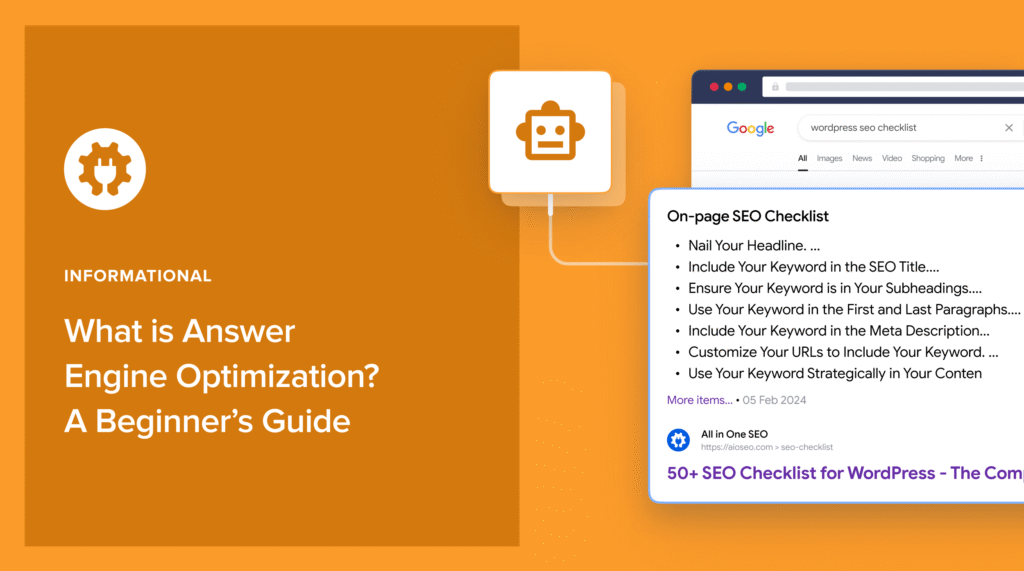If you’ve ever typed a question into Google and seen the answer pop up instantly, you’ve seen Answer Engine Optimization (AEO) in action.
Back when I started optimizing websites, my focus was all about keywords and backlinks. But the first time my content showed up as a featured snippet, read aloud by a voice assistant, it hit me. People aren’t just searching for keywords anymore. They’re asking questions, and answer engines are delivering them answers.
In this article, I’ll share what AEO is and how I use it to get my content ready for this new era of search.
In This Article
What Is Answer Engine Optimization (AEO)?
Answer Engine Optimization (AEO) is a digital marketing strategy focused on optimizing content to directly answer user queries in search engine results. It's a subset of search engine optimization (SEO).
AEO is unlike traditional SEO, which aims to rank web pages for specific keywords. Instead, with AEO, you target:
It also targets other formats and SERP features that provide immediate answers to users' questions.
Why Is Answer Engine Optimization Important?
The significance of AEO is closely tied to 3 major trends in search: the rise of voice search, the increasing prominence of featured snippets, and the emergence of AI Overviews.
Voice search has exploded in popularity with the advent of smart speakers and voice assistants on mobile devices. Users are now more likely to ask complete questions rather than type keyword phrases. This makes it crucial for websites to optimize for natural language queries.
Featured snippets, also known as “Position Zero” results, appear above traditional organic search results and provide concise answers to user queries.
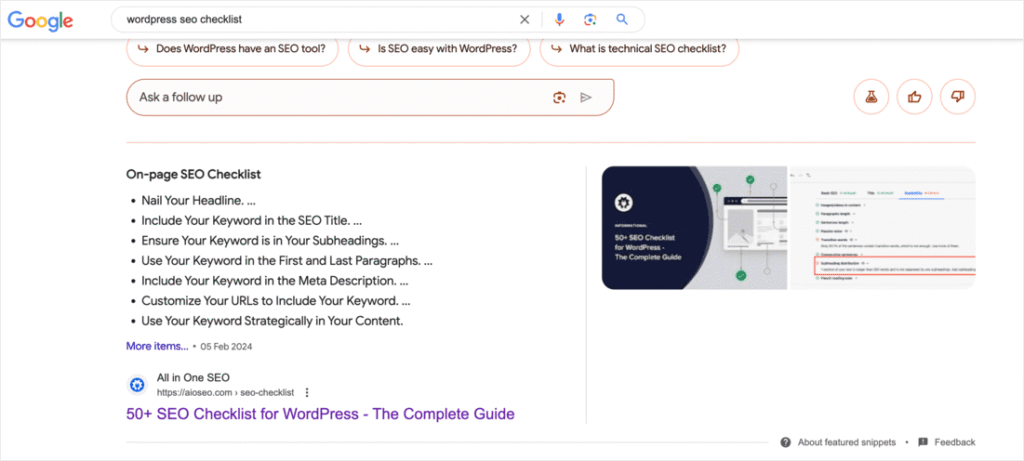
These snippets are often read aloud by voice assistants, making them doubly important for visibility in both text and voice search results.
AI Overviews are a new feature in Google Search that uses generative AI to create summarized answers directly on the results page.
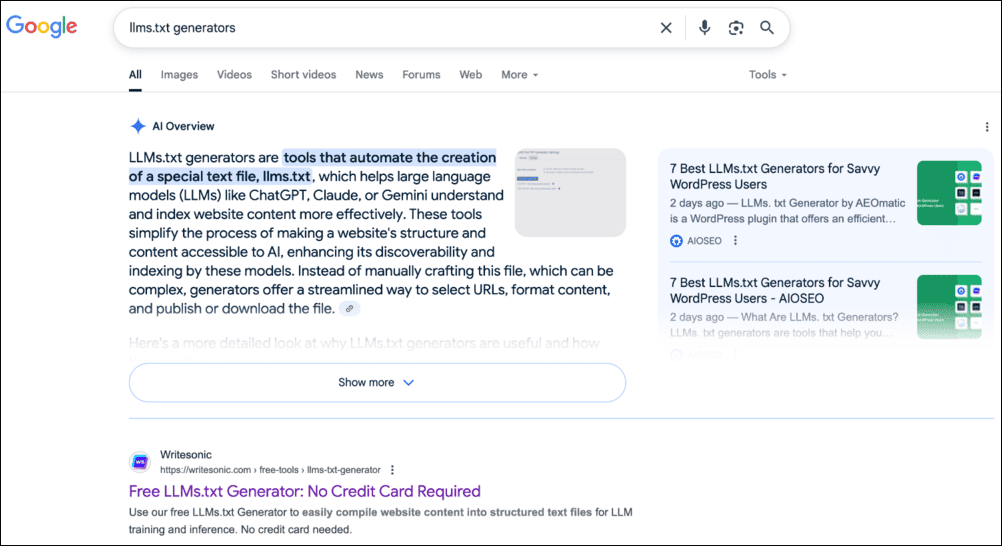
These overviews pull information from multiple sources. This makes it more important than ever for your content to be clear, authoritative, and well-structured. Optimizing for AEO increases the chances of your content being cited in AI-generated summaries. This puts your brand front and center in this emerging search experience.
In short, you should focus on AEO to:
- Increase your chances of appearing in featured snippets.
- Be cited in AI Overviews to capture attention at the very top of search results.
- Improve your visibility in voice search results.
- Drive more targeted traffic to your site.
- Enhance brand awareness and authority.
Answer engine optimization is crucial to running successful SEO campaigns. It helps you tap into question-based queries and capture search traffic in that category.
AEO vs. SEO: Understanding the Difference
While AEO and SEO share the common goal of improving online visibility, they differ in their approach and focus.
SEO is a broad strategy aimed at improving a website's ranking in search engine results pages for specific keywords. It encompasses various techniques, including on-page optimization, link building, and technical improvements to a website's structure and performance.
AEO, on the other hand, focuses on answering user questions directly. Rather than simply targeting keywords, AEO targets specific queries. These are often phrased as questions and aim to deliver the most relevant, concise answer possible.
I first saw the difference in action when a blog post I’d optimized for a common “how-to” query showed up as a featured snippet and got read aloud by a voice assistant. The traditional SEO work helped it rank. But it's the AEO-focused structuring and direct answer format that earned it visibility in multiple formats.
Because they complement each other, use both strategically to boost your chances of ranking on search engines.
Best Practices for Answer Engine Optimization Strategies
Ready to get your answer engine optimization game on?
Here are some tips on implementing an effective AEO strategy.
1. Use the Right Answer Engine Optimization Tools
One of the first tools to include in your answer engine optimization toolbox is All In One SEO (AIOSEO). This is because the plugin helps you optimize your content with a focus on SEO.
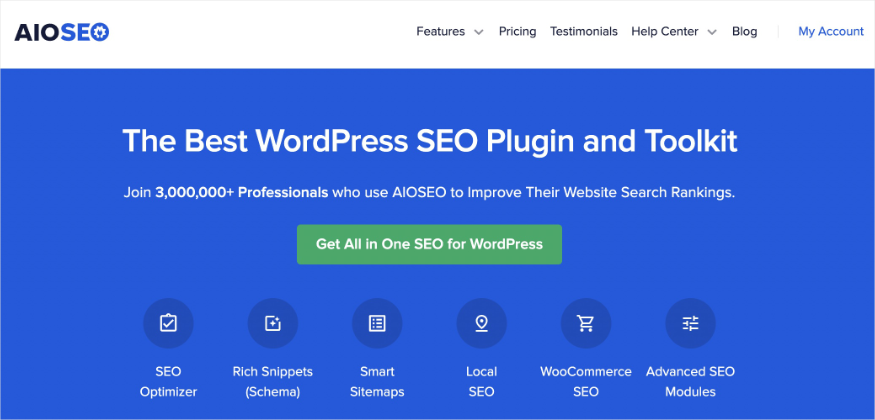
AIOSEO is a powerful WordPress SEO plugin boasting 3+ million active users. Many marketers and bloggers trust the plugin to help them boost their search engine rankings and traffic. That’s because the plugin has many powerful features and modules to help you properly configure your SEO settings.
When it comes to AEO, some of the modules you’ll find helpful include:
AI Content Generator
AIOSEO's AI Content Generator is a powerful module that can help you with AEO. It's an AI-powered feature that helps you repurpose your blog content into various formats.
One of the content types you can create with it is FAQs.
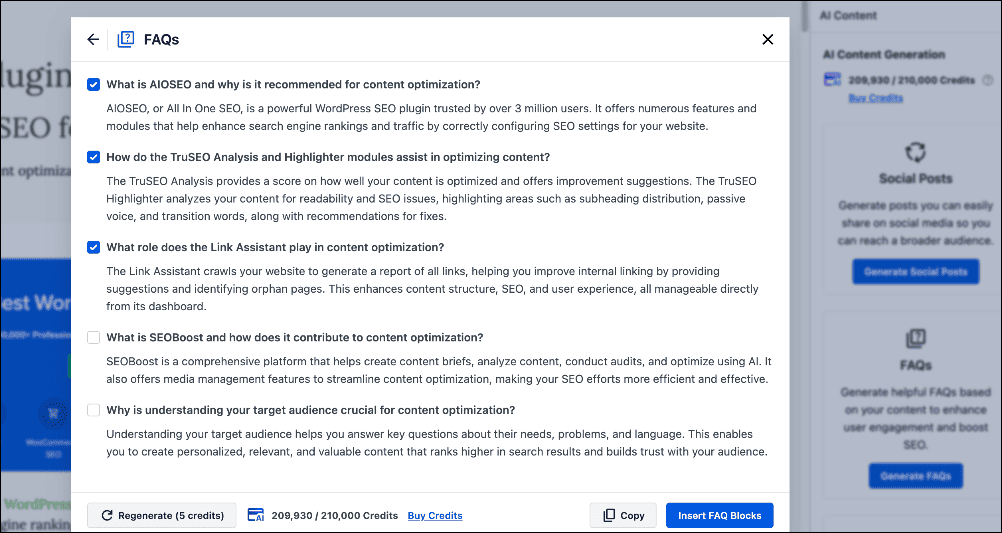
You can instantly generate relevant FAQs and their answers, complete with FAQ schema. These boost your SEO and also keep readers engaged. Once generated, just pick the FAQs you like and click Insert FAQ Blocks to add them to your post. Alternatively, copy them for use anywhere else.
Check out our article on using FAQ blocks to boost SEO for more information on the importance of FAQs.
Besides FAQs, AI Content also generates key points.
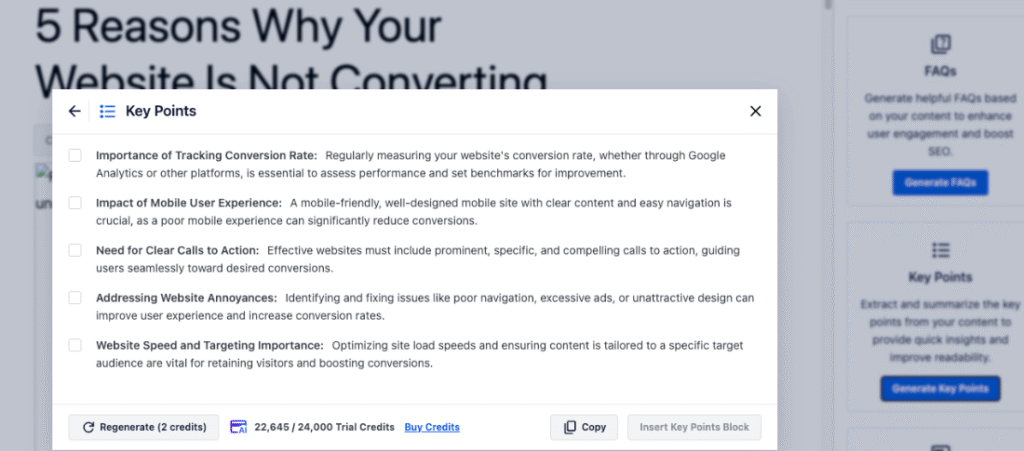
Key Points highlight your article's core concepts or essential takeaways. You can seamlessly add them as a TL;DR at the beginning of your content or as a summary at the end. They're excellent for providing quick insights and significantly boosting readability.
FAQs and Key Points are a great way to optimize your content for featured snippets, voice search, and AI overviews.
Other content types AI Content helps with include:
For more details on this revolutionary tool, check out our tutorial on using an AI content writer in WordPress.
TruSEO Analysis
AIOSEO’s TruSEO On-Page Analysis gives you a score of how well-optimized your content is.
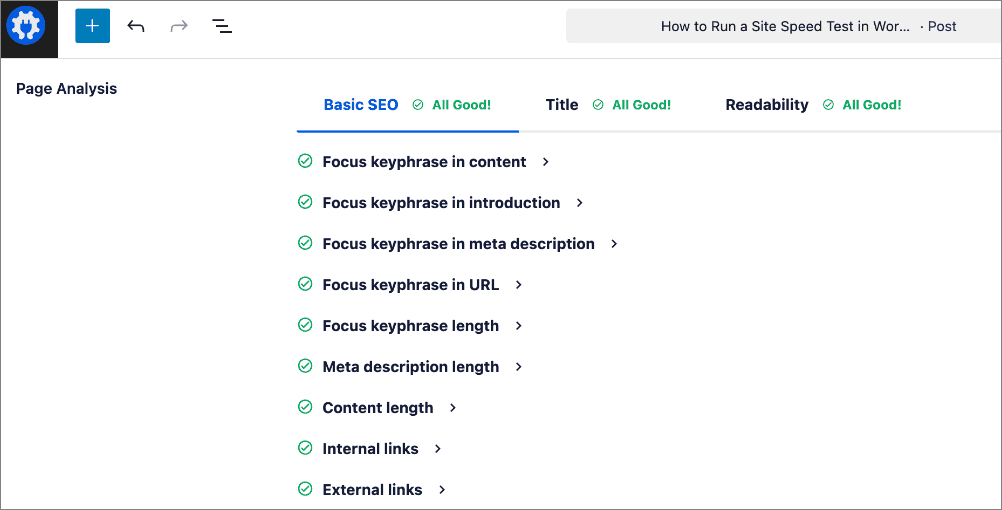
It even gives you recommendations for improving it so your content is optimized for SEO. This has been a real time saver for me, especially when I want to quickly spot optimization opportunities in my content.
TruSEO Highlighter
AIOSEO’s TruSEO Highlighter is a great tool that helps you nail your on-page SEO on the fly.

The TruSEO Highlighter analyzes your page content and makes readability recommendations. It highlights items that include:
- Subheading distribution
- Passive voice
- Transition words
AIOSEO’s TruSEO gives you recommendations for fixing any on-page SEO errors it finds. This way, you can rest assured that your content is optimized.
Next-Gen Schema Generator
Another module in AIOSEO that can bolster your answer engine optimization strategy is the next-gen Schema Generator.
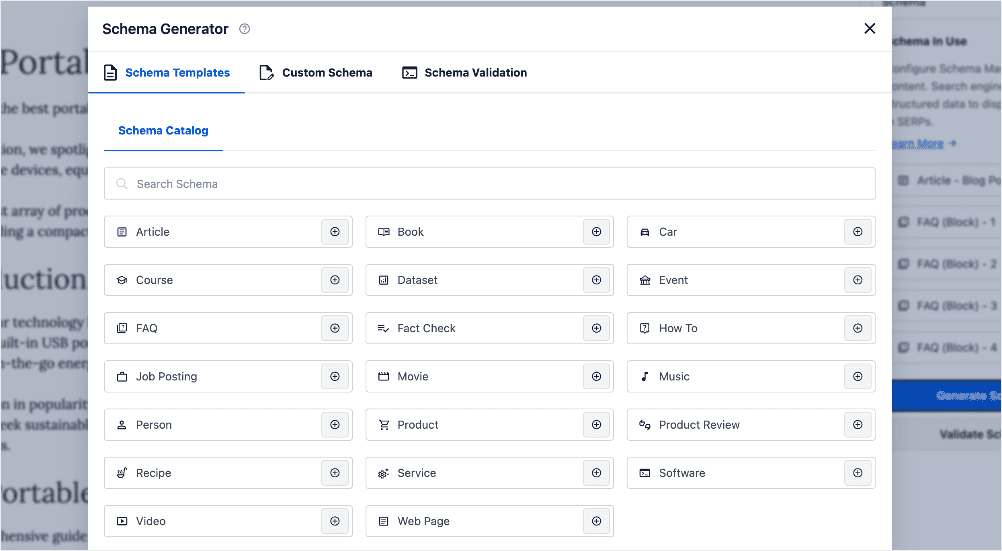
You can use this tool to add different types of schema markup on your pages, making it easier for search engines to understand your content. It also helps improve your chances of getting rich snippets on SERPs. For an eCommerce store, it can even help you add product and shipping information to your search listings.
More on schema markup in a moment.
In the meantime, you can check out our guide on structured data for an in-depth look at the importance of schema markup.
For step-by-step instructions on how to install AIOSEO, check our detailed installation guide.
2. Understanding Search Intent/User Intent
Understanding search intent (also called user intent) is a fundamental aspect of Answer Engine Optimization. Search intent refers to the underlying purpose behind a search query, and can be categorized into four main types:
- Informational intent: Users are seeking knowledge or answers to specific questions. For example, a query like “What is AEO?” demonstrates a clear desire for information.
- Navigational intent: Users aim to reach a specific website or page, such as searching for “AIOSEO login.”
- Commercial intent: Users are researching products or services with the intention of making a purchase, e.g., “best running shoes.”
- Transactional intent: Users are ready to complete a purchase or action, such as “buy iPhone 14 online.”
By analyzing search intent, you can tailor your content to meet user needs effectively. For instance, let's say your research shows that many users are asking, “What is AEO?” Creating a clear, concise answer positions your content as a valuable resource. It also aligns it with the user's search intent.
To effectively analyze user queries, consider using tools like Google Analytics, Semrush, or Ahrefs. These can provide insights into the types of questions users are asking.
Additionally, examining the “People Also Ask” section in search results can help identify common queries related to your topic.
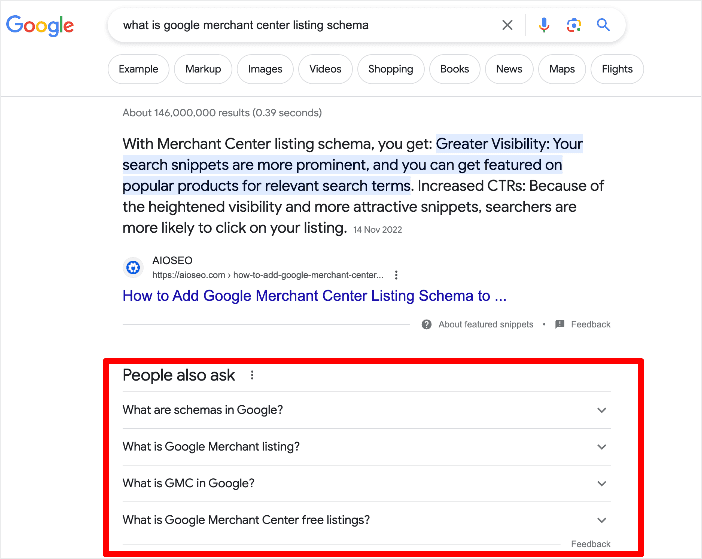
By addressing these questions in your content, you enhance its relevance and increase the likelihood of appearing in featured snippets or other direct answer formats.
3. Implement Schema Markup/Structured Data
Structured data is code you add to your website to make your content easier for search engines to understand. It uses a standardized vocabulary, called schema markup, to define details about your pages.
Implementing schema markup is a crucial component of AEO. This is because the additional context it provides helps search engines understand the meaning and purpose of your content. As a result, it's easier for them to display your content in direct answers on SERPs.
For example, if your website includes a recipe, using the recipe schema markup allows search engines to identify the ingredients, cooking time, and nutritional information. This can lead to rich snippets that display this information directly in search results. As a result, you enhance your visibility and boost click-through rates.

To effectively implement structured data, start by identifying the most relevant schema types for your content. Once that's done, adding the right schema markup is super easy with AIOSEO’s next-gen Schema Generator.
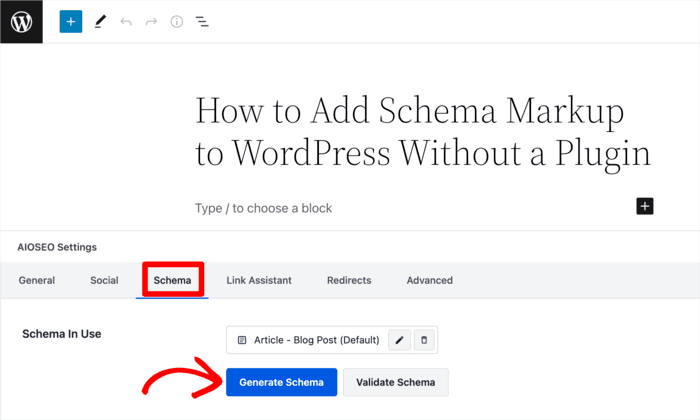
This powerful feature makes it easy to add schema markup on your site, even if you don’t have any technical or coding experience.
Why Schema Matters for Answer Engine Optimization
Answer engines like Google’s AI Overviews work best when your content is clearly defined and structured. Adding schema markup gives them exactly what they need to:
- Deliver direct answers to specific questions.
- Pull accurate step-by-step instructions.
- Highlight key facts and features.
- Understand product details instantly.
This isn’t just technical SEO, it’s answer engine optimization. Schema makes your content answer-ready for all search engines.
For detailed instructions, check out our guide on adding schema markup in WordPress.
4. Provide Concise and Clear Answers
Providing direct answers is vital for effective AEO. Users today are looking for quick, straightforward responses to their queries. And crafting content that meets this demand is essential. To achieve this, consider the following best practices:
Clear and Concise Writing
Write in a straightforward manner. Avoid jargon and complex sentences that may confuse readers. Your goal should be to answer the question directly within the first few sentences.
FAQ Sections
Incorporating FAQ sections can effectively address common questions.
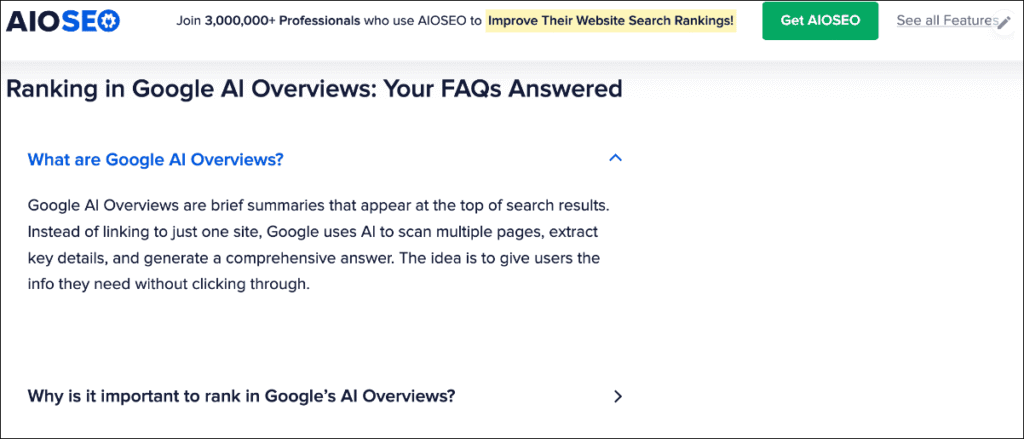
This format allows you to provide succinct answers while increasing the likelihood of ranking in answer engines and for AI-driven queries.
Natural Language
While keywords are still important, your writing should prioritize natural language that resonates with users. Overusing keywords (keyword stuffing) can detract from the user experience. Instead of using the same keyword, use synonyms or aim for a balance that maintains readability while still being optimized for search engines.
Check out our list of the best keyword density checkers to help you maintain a good balance of keyword usage.
By focusing on clarity and conciseness, you ensure that your content meets the needs of both search engines and human users. This dual focus enhances the chances of your content being featured in direct answers. Ultimately, it drives more traffic to your site and improves user satisfaction.
5. Pay Attention to Content Organization
Effective content organization is essential for both user experience (UX) and SEO. A well-structured piece of content makes it easier for readers to find the information they need. It also helps search engines understand the hierarchy and relevance of the information presented. Here are some tips for structuring content effectively:
Use Descriptive Headings
Headings (H1, H2, H3, etc.) should clearly describe the content that follows. This not only aids in navigation but also helps search engines index your content appropriately. For example, instead of a vague heading like “Overview,” use “Overview of Answer Engine Optimization (AEO).”
Break Content Into Sections
Divide your content into manageable sections with clear headings. This allows readers to scan the content quickly and find specific information. Each section should address a distinct aspect of the topic.
Use Short Paragraphs
Keep paragraphs short and focused, ideally no more than three to four sentences. This prevents overwhelming readers and maintains their attention.
Highlight Key Information
Use bold or italics to emphasize important points or keywords. This draws attention to critical information and aids in quick comprehension.
Again, you can also use AIOSEO's AI Content Generator to generate and embed key points in your content.
Organizing your content this way is a great way to help you rank for question-based queries, resulting in more organic traffic to your site.
6. Create High-Quality Content
High-quality content not only satisfies user intent but also builds trust and authority, which are critical for ranking well in search results. It’s also paramount for successful AEO.
Strategies for creating high-quality content include:
Conduct Thorough Research
Invest time in researching your keywords and topic. A great tool you can use for this is LowFruits.

LowFruits is a keyword research tool built to uncover low-competition keywords, which are perfect for landing quick SEO wins. It identifies Weak Spots on search engine results pages (SERPs), helping you target terms with a better chance of ranking.
You’ll also get helpful insights into search volume, keyword difficulty, and related terms to guide your strategy.
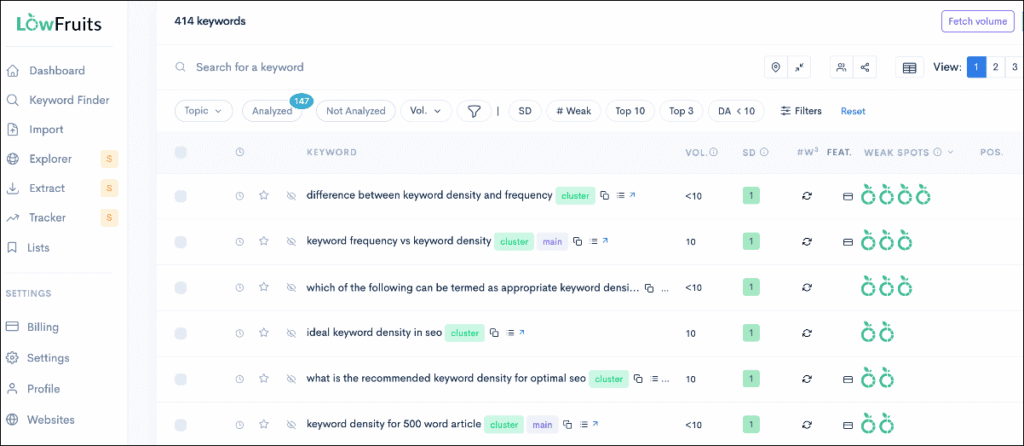
Focusing on keywords with lower competition increases your chances of ranking higher in search results more quickly.
Besides keyword research, use credible sources, such as academic articles, industry reports, and expert interviews. These are great for gathering accurate and comprehensive information.
Check out our list of the best keyword research tools for other tools to help you uncover keyword opportunities.
Demonstrate Google E-E-A-T
Incorporating Google's E-E-A-T principles into your content strategy is vital for creating high-quality content. One way to do this is to pay attention to author SEO. You can easily do this with AIOSEO’s Author SEO module:

Author SEO enhances your credibility and helps assure readers that they are receiving accurate and reliable information
Optimize for Readability
Readability describes how easy it is to read and understand your content. It can be measured with metrics like word choice, sentence length, and syllable count.
Simplifying your content makes it easier for your target audience to understand your message. This motivates the readers to continue reading, which ultimately increases engagement on your website.
You can easily check your readability score using AIOSEO’s TruSEO On-Page Analysis module.

Aim for a reading level that matches your target audience, making your content accessible to a broader range of readers.
Check out our article on improving your readability score for more details.
Incorporate Visuals
Use images, infographics, and videos to complement your text. Visual elements can break up large blocks of text and provide additional context, making your content more engaging and easier to understand.
However, you need to pay attention to image SEO, as visuals and media can negatively impact your search rankings if not handled properly.
Regular Content Optimization and updates
High-quality content is not static. Regularly review and update your articles to ensure they remain accurate and relevant. This practice not only improves user experience but also signals to search engines that your content is current and valuable.
One way to ensure your content is always relevant is to regularly optimize it using tools like SEOBoost. SEOBoost has a Content Audit feature that analyzes your content and compares it to top pages on SERPs. It then gives you recommendations on how to improve yours.
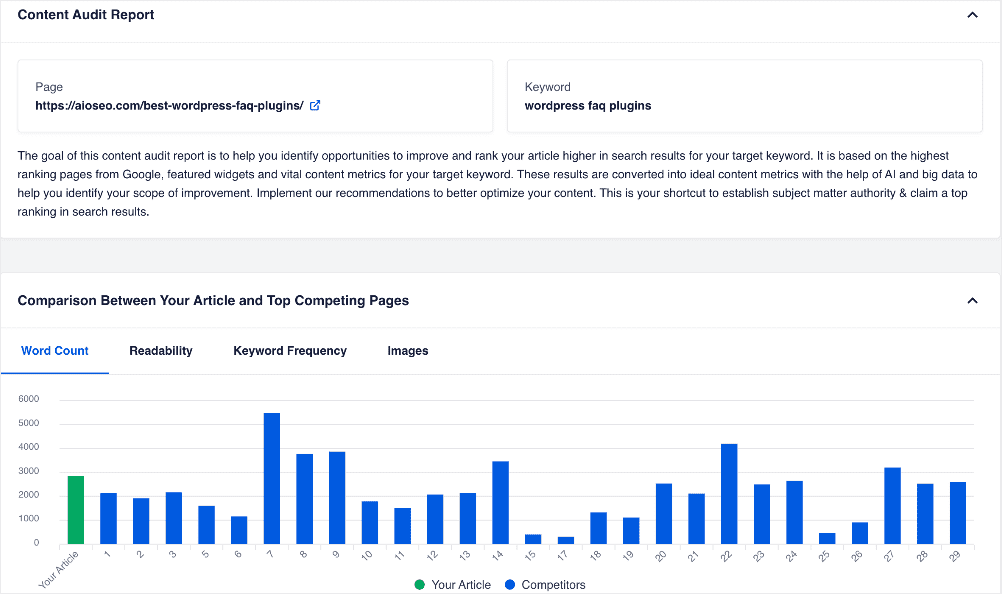
Content optimization and updates help keep your content fresh and relevant, an important ranking factor revealed in the Google search algorithm leaked documents.
Employing these strategies can help you position your brand in the coveted “position zero.” As a result, you gain increased visibility and authority in your niche.
Boost Your Online Visibility With Answer Engine Optimization
Answer engine optimization (AEO) is a smart way to get your content noticed and reach more people online. By giving clear, simple answers and optimizing for voice search and featured snippets, your content can be featured in many SERP features. The increased search visibility brings more of the right visitors to your site. It also helps you build trust and show expertise in your field.
When you use AEO together with regular SEO, you give your site the best chance to stand out and meet your audience’s needs in today’s competitive online world.
I hope this post has helped you know what answer engine optimization is and how to implement it on your site. You may also want to check out other articles on our blog, like our proven SEO tips to boost search rankings for beginners and our list of the best AI SEO tools.
If you found this article helpful, then please subscribe to our YouTube Channel. You’ll find many more helpful tutorials there. You can also follow us on X (Twitter), LinkedIn, or Facebook to stay in the loop.
Answer Engine Optimization: Your FAQs Answered
What is an answer engine?
An answer engine is a search tool designed to provide direct, concise answers to users’ questions rather than just a list of links. It uses AI and structured data to deliver immediate responses through features like featured snippets, voice assistants, and AI-generated summaries.
What is answer engine optimization?
Answer Engine Optimization (AEO) is a digital marketing strategy focused on optimizing content to directly answer user queries in search engine results.
AEO vs. SEO: What's the difference?
Answer Engine Optimization focuses on optimizing content to directly answer user queries, while SEO (Search Engine Optimization) aims to improve overall website visibility for specific keywords.
Why is Answer Engine Optimization important?
AEO helps your content show up for question-based searches, increases your chances of appearing in voice search results, improves visibility, builds brand trust, and drives more targeted traffic to your site.
Disclosure: Our content is reader-supported. This means if you click on some of our links, then we may earn a commission. We only recommend products that we believe will add value to our readers.
